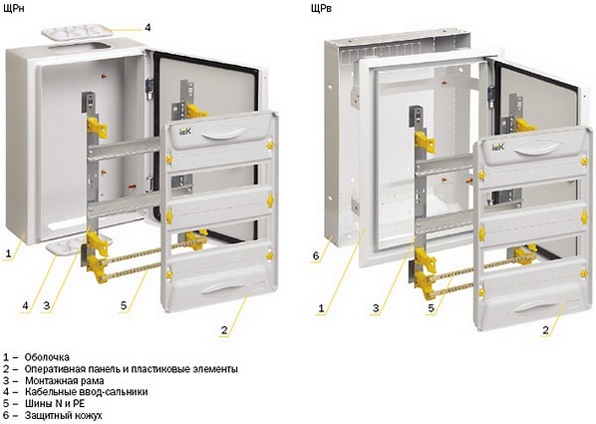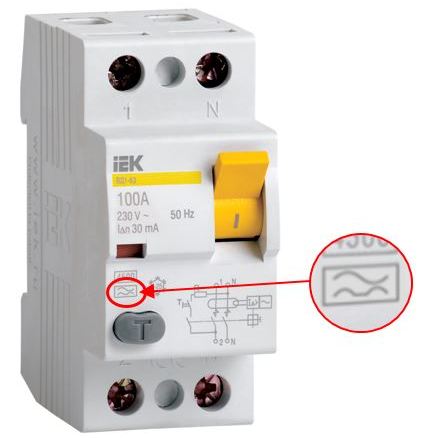Categories: Featured Articles » Controversial issues
Number of views: 3785
Comments on the article: 0
Someone is right on the Internet! Or what do electricians say
Forums and social networks have long been the place to address many, including professional, issues. Often, experienced professionals turn to colleagues for advice. So, installers are looking for the support of designers in terms of knowledge of standards, and designers ask "practitioners" about the actual installation conditions of a particular equipment. True, some tasks are so complex that they cannot immediately find the truth and a dispute erupts.
In this article, we will try to understand three frequent discussions:how many places to choose a box, where to put an RCD and what protective devices are needed for a computer.

How many places do you need to choose boxing?
Given: in the electrical circuit of the switchboard, an automatic switch VA 47-29 3P 63 A for input, five differential automatic machines AD 12 2P 16 A / 30 mA and seven VA 47-29 1P 10 A are provided.
Side one: “We need a 24-seater shield: 20 places are occupied, we add a reserve of 20%, that is, four more places.”
Side Two: “You should not even take less than 36 positions. It is very difficult to dodge in the boxing space by 24, and all that needs to be installed and connected there ”.
In fact
It all depends on where the box will be mounted. If we are talking about a housing shield, it is better to still have a small and at the same time aesthetic shell, for example, a plastic box ShchRV-P-24 measuring 360 x 306 mm. So the installers will have to show the wonders of micromotorics and resourcefulness.
OPINION OF THE SPECIALIST
Nadezhda Petrova, Head of Metal Cases, IEK GROUP, one of the leading manufacturers and suppliers of electrical and lighting engineering:
- With limited space inside the box, a removable mounting frame is a good solution - it allows you to “assemble” all devices outside the case. We took this into account in the modular distribution metal cases ЩРн and ЩРв of the UNIVERSAL series. Also, for the convenience of cable laying in this series, the distance between the rear wall and the DIN rail has been increased, and the DIN rails themselves are installed with a pitch of 125 mm.

IEK® UNIVERSAL Modular Metal Enclosures with Removable Mounting Frame
If the shield is mounted in production, then a 36-seat box will be more suitable. In this case, “thrust everything back to back” is not welcome, and 20% of the regulatory reserve will not be saved. Life does not stand still, enterprises are developing, new equipment is being purchased, the connection of which may require additional space in the panel.
OPINION OF THE SPECIALIST
Alexander Shulgin, master of the Krasnoyarsk regional energy company:
- Each energy company that provides the connection of the enterprise to the power grid has technical conditions that clearly define the requirements for what and where it should be (emergency, operation automation, relays, load disconnection automation, and so on).
However, in addition to, so to say, the main filling of the shield, there are many different small things - as a rule, a grounding bus, zero, various insulators are separately installed. All this requires a place, and switching must be provided for - and the very normative reserve is eaten cleanly.
Where should I put an RCD: at the input or at the outgoing lines?
Given: electrical diagram of the apartment panel.
Side one: “In the apartment, an RCD or a differential machine must be at the entrance! RCDs or difratomata, necessarily selective with an input device, can also be on the outgoing lines. ”
Side Two: “If all the necessary conditions have been taken into account, then differential protection along the lines may be sufficient in the apartment switchboard.”
In fact
It is important to evaluate each specific situation. So, p.7.1.72 PUE reads: “If the overcurrent protection device (circuit breaker, fuse) does not provide an automatic shutdown time of 0.4 s at a rated voltage of 220 V due to low values of short-circuit currents and the installation is not covered by the potential equalization system, the RCD installation is mandatory. ”
Thus, the need to install an RCD both at the input and at the outgoing group lines is determined by the design organization on the basis of ensuring maximum safety, compliance with standards and customer requirements.
Recall that the use of RCDs is mandatory for group lines supplying plug connectors for an outdoor installation (GOST R 50571.8-2018 “Energy Efficiency”) or for protecting plug sockets in bathrooms and showers if they are not connected to an individual distribution transformer (GOST R 50571.11-96 “ Requirements for special electrical installations. Bathrooms and showers ").
In general, the installation of differential protection devices is recommended to be carried out in separate group lines; several groups can be connected to one RCD through separate circuit breakers.
OPINION OF THE SPECIALIST
Irina Orlova, power supply network designer:
- To simplify and speed up the installation process, save space in the panel and increase the reliability of the network, instead of a bunch of "RCD + automatic" I recommend using differential current switches.
In the first case, the equipment occupies three modules in the shield, in the second - usually two. However, you can find a single-module design - the same AVDT32M IEK has a width of only 18 mm. When approaching "RCD + automatic", you must first connect the phase to the automatic, then from its output make a jumper on the RCD and connect zero to the input of the RCD.
In the case of AEDT, the number of actions and switching is reduced to a minimum, since the phase and zero are immediately brought to the input terminals. And in the end, the fewer jumpers, the more reliable.

AVDT32M IEK® - compact replacement of a difavtomat or a combination of VA + RCD
What protective devices are needed for computers?
Given: computer power network in a large business center.
Side one: "Differential circuit breaker or steam circuit breaker and RCD."
Side Two: "If the input circuitry provides protection against leakage currents, then a conventional circuit breaker will be sufficient on the group line."
In fact
Regulatory documents do not oblige to protect computer networks from differential currents. If the power supplies of the equipment are modern and high-quality, the cords are not damaged and the network is three-wire, then the installation of standard RCDs of the AC type, which respond to alternating damage currents, is impractical.
But the apparatus of type A, disconnecting the network when not only variables, but also pulsating fault currents appear, may well come in handy. In Europe, such devices have been used for more than 10 years, moreover, in accordance with the requirements of foreign electrical standards, universally change the device type AC to type A.

Type A marking mark on the VD1-63 IEK® enclosure (RCD)
In some aspects, Internet disputes are turning into real fights. However, in general, theorists and practitioners in the design and installation of electrical networks live together - because some simply cannot exist without others.
Material prepared by the press service of IEK GROUP
See also at bgv.electricianexp.com
:

